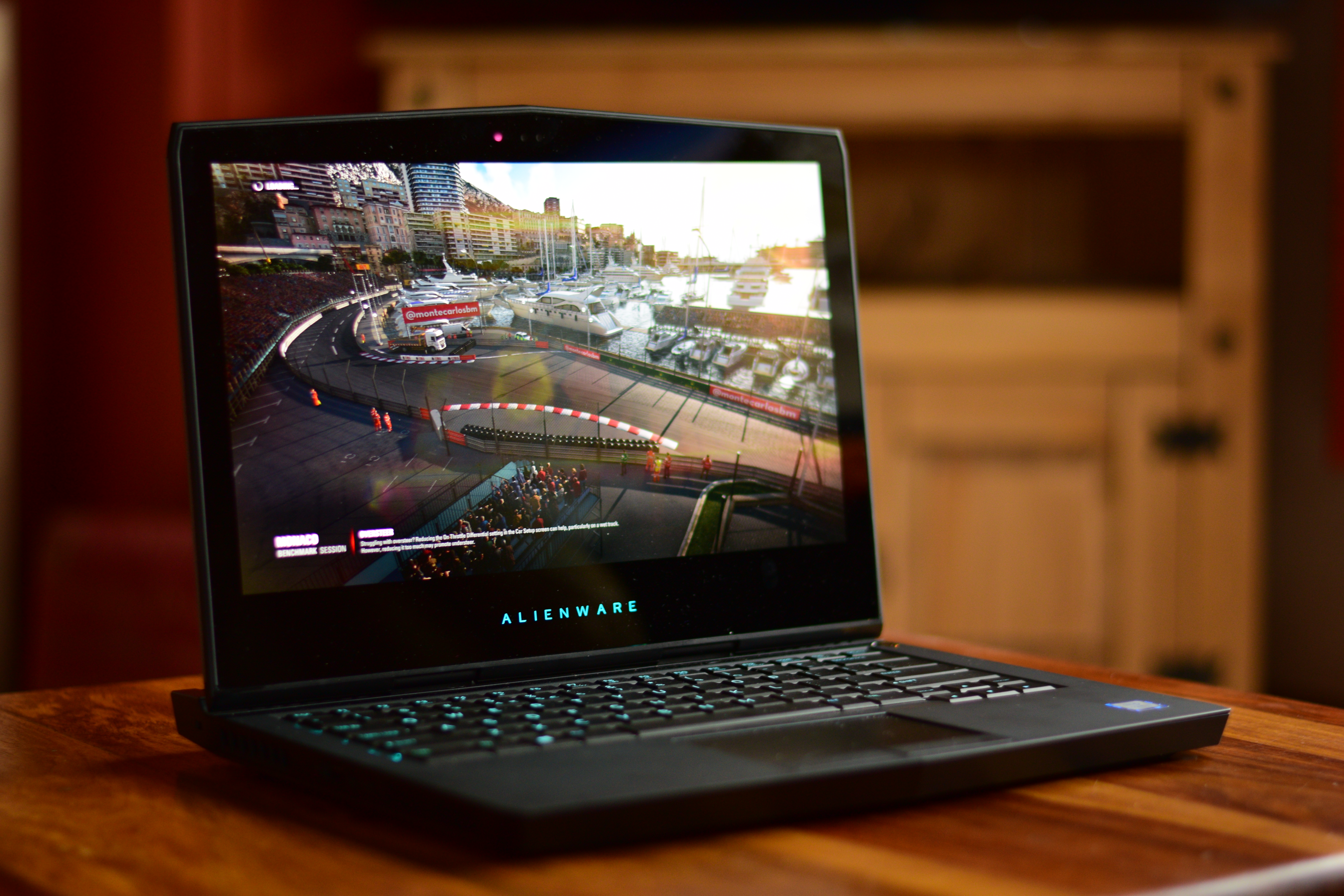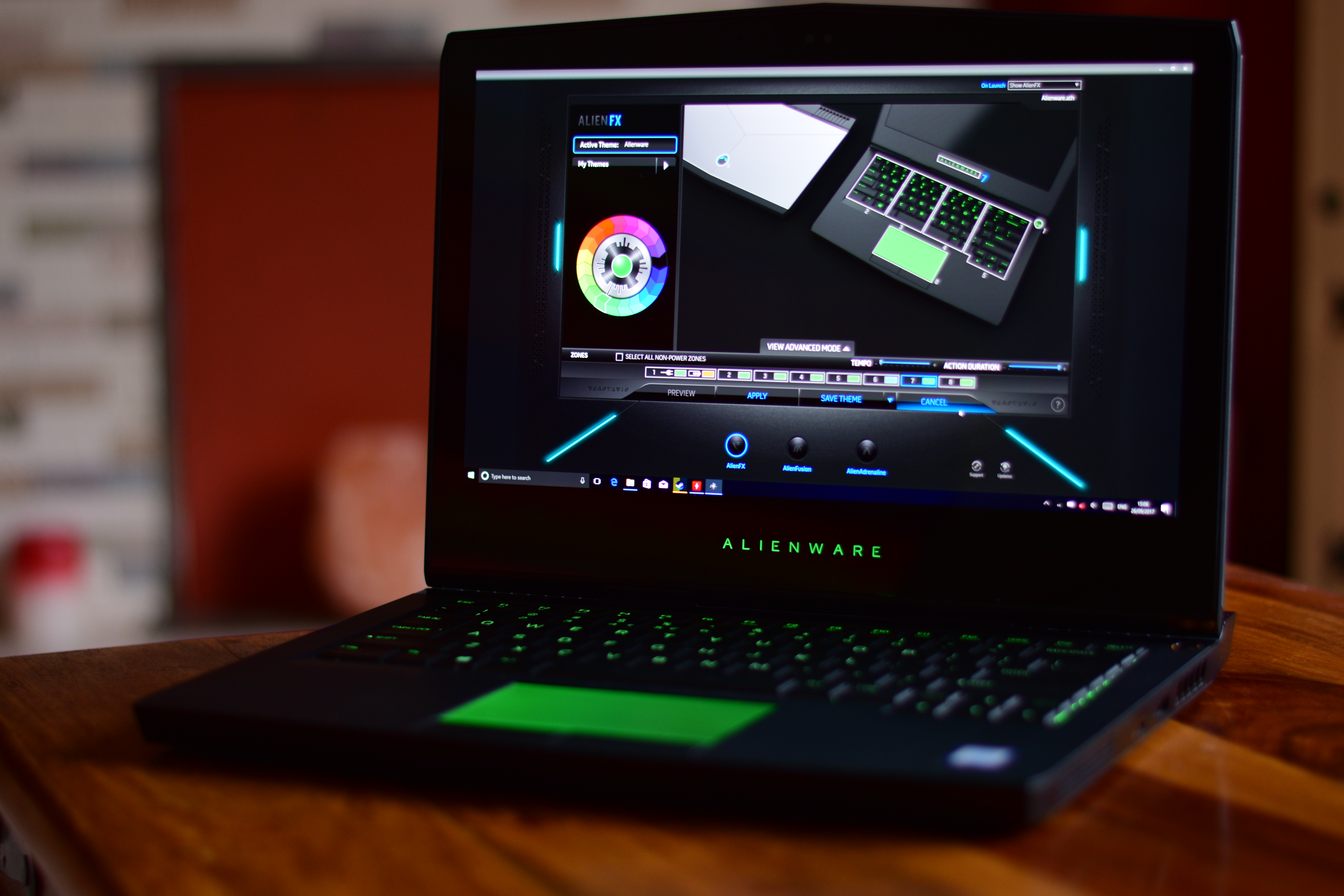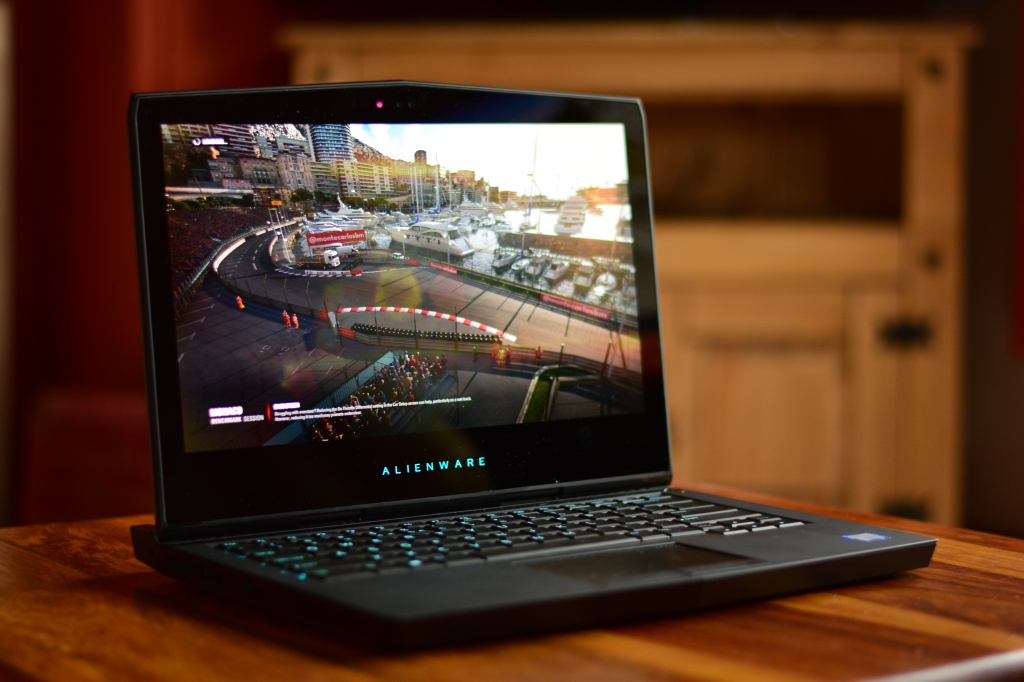
Review unit supplied by Alienware for testing.
The Alienware name has always split opinions, with many viewing the company as overpriced while others see them as creating luxury products that are worth the extra money. Regardless of where you stand on the brand I think we can generally agree that they make solid machines, and I’ve gotten to review a few of them. I’m back again, this time with a chunky gaming laptop sporting an equally chunky asking price.
Running at a resolution of 1440p one could almost view it as overkill for the relatively small 13.3″ panel as higher resolutions sometimes aren’t all that beneficial unless on bigger screens where those extra pixels can make all the difference. However, since you’re traditionally going to be sitting quite close to the laptop the higher resolution makes a notably pleasing difference when gaming or just browsing the web thanks to detailed images. With that said whether you’ll personally be able to notice and appreciate the 225.9 pixels per inch comes down to your eyesight.
Arguably the single best thing on the entire Alienware 13 is its panel. OLED screens still aren’t that common on the laptop scene, which is a shame because the deeper blacks produced really help make games look prettier, contrasting beautifully with vibrant colors, although given the price of them it’s not surprising that they aren’t common yet. It’s the pricey OLED version of the Alienware 13 I got in for review, and it’s so damn beautiful that it could almost make you forget the extra pennies you’d have to pay to get it. Toss in incredible response times that make gaming and general use feel uber smooth and you’ve got a real winner. Oh, and as a bonus, it’s a touchscreen just in case you fancy getting grubby finger marks all over it!

Build quality certainly isn’t lacking. The problem with high-end laptops is weight as the increased oomph under the hood comes at a price. The hefty 2.6KG of weight makes the Alienware 13 a tricky beast to cart around, as does it’s the thickness of 31mm that means it doesn’t fit in most 13″ laptop bags. The hefty power brick doesn’t help, and you’re certainly going to need it unless you only need the laptop for short stints as we’ll see later on. The frame is solid with no bend to be found, while the soft-touch plastic that wraps around the keyboard and touchpad are most welcome. In other words, while its weight may be a detriment to practicality it does make the whole machine feel like a premium product, albeit one that could potentially wipe out a small city if you accidentally dropped it.
Happily, there’s no overly gaudy design going on, either. Sure, you do have the LED lighting and the Alienware logo plastered on the lid, but Alienware have kept their laptop to a reasonably simple design style. There’s no stupid angles or daft pointy bits which makes the laptop feel like something you’d be happy pulling out on a train, at work or in a café. Hell, I wrote a good chunk of this review using the Alienware 13 on a train home from Glasgow. With that said it’s not exactly a pretty beast, especially because of the fact that hinge doesn’t sit flush with the rear of the laptop.
The keyboard isn’t mechanical despite the price tag and initially it felt feels squishier than I’d personally like, but typing on it feels good with minimal pressure needed to achieve the 2.2mm of travel before activation. A solid metal plate underneath the keyboard stops any flex as you type or game which makes it feel leagues better than cheaper laptops on the market where you hit a key during a frantic moment of action in a game and feel like you’re going break the whole laptop in half. It doesn’t feel cramped, either, and so I had no trouble hammering out words at my normal pace.
The touchpad does a damn fine job, too. Obviously, no trackpad could truly ever replace a mouse, but for browsing the web it’s responsive and accurate. The physical left and right clicks are a plus, too, although I did note that they had a little bit of wobble on my test model. Given that these review units get handed around a lot, though, I’m not overly concerned.
Both the keyboard and the trackpad get the benefit of full RGB LED lighting so that you never have to worry about losing the damn thing in the dark. While it obviously doesn’t serve any practical purpose having the trackpad light up along with the keyboard is kind of cool. Be warned, however, the lighting does drain the batter quite a bit, so personally, I found myself keeping it turned off. Using the inbuilt software you can select between a few different settings, such as color cycling, and play around with the four different zones that break up the keyboard so that you can have one area gree, and another red and so on. In total there are nine different customizable zones.

You also get a webcam with a reasonable microphone, but considering the price of the Alienware 13 the video quality is disappointing. You’ll be able to chat to your mates, just don’t go expecting to use it for much else.
Under the hood we’ve got the Intel i7-7700HQ processor coupled with a Nvidia GTX 1060 graphics card and 16GB of RAM, making for a reasonably powerful package all-round. The model I got in for review only comes with a small 256GB SSD which keeps Windows 10 feeling nice and quick, but it filled up as soon as I placed a few games on it for testing. Frustratingly there are no options when buying the laptop to get a secondary hard-drive, instead Alienware only offers bigger but hugely expensive SSD drives, up to a 1TB.
Speaking of versions, the one I have here is the most expensive variation coming at a slightly terrifying £1,849.00. Dropping down to £1,499.01 the amount of RAM gets halved, you don’t get the OLED screen which gets replaced with a much less impressive 1080p, and the graphics card is knocked down to the GTX 1050 TI. There are another two tiers underneath that, but they’re all customizable so you can always take less RAM in order to get a bigger drive or steal your child’s piggy bank in order to get the OLED panel. Even at its cheapest price of £1,249.00 the Alienware isn’t cheap, and it’s fair to say that you are paying quite a bit for the name.
All that oomph does mean there’s a fair bit of heat generated out the back with the processor managing to reach temperatures of 100c when it’s under heavy load. The machine does a good job of keeping it reasonably quiet, though, as the fans don’t bother kicking in under light loads, so things only start to get noisy when you stress the whole system. With that said if you’re gaming on a laptop you’ll probably be wearing headphones anyway.
However, if you’re just watching movies or YouTube vids then the speakers do their job quite well which was a genuinely pleasant surprise. There’s some tininess to be found and they don’t exactly pack a lot of punch in terms of bass, but they can be ratcheted up quite loud with minimal loss of clarity, helping to combat any fan noise the machine is producing.
Still, the tradeoff for the heat and potential noise is great gaming performance across the board. For testing I ran the laptop through a series of games, as seen below, on the native resolution of 1440p with everything maxed out unless otherwise stated. Many of these games have in-built benchmarking tools and thus aren’t completely accurate representations of real-world gameplay, but typically they tend to stress a system more than the regular gameplay will. As for The Witcher 3 I took a gentle ride through the countryside into Novigrad where the CPU starts to work quite hard, while in Mad Max I opted to hunt down a convoy and engage in a friendly bit of murdering. Finally for Metal Gear Solid V: The Phantom Pain I assaulted an airport, first by flying in on a helicopter while gunning down people with a minigun, and then on foot. Keep in mine that MGSV:TPP is limited to 60FPS no matter what. So let’s take a look at the results.
The GTX 1060 sitting inside the Alienware is a competent card but we can certainly see it struggling to run games with max settings at 1440p, which isn’t all that surprising. It’s something of a testament to both Mad Max and F1 2017 that they look so damn good yet run very, very smoothly on a variety of hardware. Regardless, across the board we see some very low minimums, and while I was watching the benchmarks I often noted wildly inconsistent framerates, especially in Hitman. Ultimately what we see is that you’d probably be better dropping the resolution to 1080p for gaming, or have to drop the settings quite a lot to get that magical 60FPS while playing at 1440p
As for battery life this is where gaming laptops typically suffer as their increased power equals much bigger drains on the battery. However, the Alienware 13 did a surprisingly good job when it comes to common, everyday tasks. On my first test with the screen set to 75% brightness, 50% volume and Windows 10 commanded to turn everything off once the laptop hit 10% battery I set a 1080p 2-hour movie to repeat over and over until everything shut down. The machine managed to last a pretty decent 5-hours and 12m. On the next test I kept the same settings and then allowed the Youtube autoplay system to simply go from video to video at 720p. This time the Alienware 13 managed a shade over six hours before it shut down. But what about gaming? Well, here we find that the GTX 1060 can munch down battery power quicker than I hoover up sushi, with a looped version of the F1 2017 benchmark tool draining the laptop in just a little over an hour. In other words if you want to game, you need to have it plugged in.

Getting to the machine’s innards is pleasingly simple; just flip it over, unscrew a few screws and voila, you have access to the RAM and drives for easy upgrading.
On the I/O side of things the laptop is reasonably well equipped with the back being home to the power adapter, Alienware’s proprietary amplifier connection, a Gigabit Ethernet port, a Thunderbolt 3 port, mini-display port and an HDMI slot for plugging it into a monitor or TV screen. You also get a total of four USB slots (two Type A, two type C) and audio connections for a microphone and headphones. That’s an impressive selection of connections.
Overall I had my grubby hands on the Alienware 13 for several weeks, including some travel time where it’s weight did prove irritating, but never stopped me from regretting the choice as playing a bit of Dawn of War III on the train was good fun. It was sitting while sitting in an uncomfortable train seat that I began a difficult debate with myself over the OLED panel and the graphics card. The OLED display is truly beautiful to behold, but the simple fact of the matter is the GTX 1060 just isn’t powerful to really handle 1440p gaming, which means you’ll either be dropping graphical settings down by a lot or switching the resolution to 1080p. That raises the question of whether the OLED display is really worth the huge amount of extra cash, and it’s tough to answer that. Movies really benefit from the deep blacks, lovely colours and beautiful contrast, but would most people really watch enough movies on their laptop to justify the price? And while the picture quality makes games look even better, it arguably makes a lot more monetary sense to just go with a 1080p panel so you can get higher settings while hitting that magical 60FPS threshold.
Alienware’s own argument would be their external graphics amplifier, which I’ve mentioned previously in another review. This box connects directly to the laptop and can have any current AMD or NVIDIA card slotted into it, at which point all of the graphics workload gets shifted from the laptop’s internal card to the external amplifier. IN other words, with the Alienware 13 when you get home you could plug in the GTX 1070 or GTX 1080 outfitted amplifier in order to get the best out of the OLED screen. That’s a pricey solution to the problem, though, and the laptop alone is expensive enough as it is without coughing up more.
Pushing aside the tricky topic of pricing and value for money since it’s a very difficult thing for people to agree on there’s no denying that Alienware continues to make quality feeling products. The overall build and presentation are fantastic, and the OLED screen is the highlight of the whole package, delivering deep blacks and vivid colours. The only pitfalls here are the weight and reasonably short battery life, which makes it more of a desktop replacement for gaming that you can unplug and take with you for light work tasks, although don’t expect it to last a full workday. If you ignore price then you’re getting a hell of a product that perhaps has a touch of design conflict between it’s OLED screen and it’s graphics card. If you do factor in price then…well, it all depends on how much you want to pay, doesn’t it?
Follow @wolfsgamingblog





